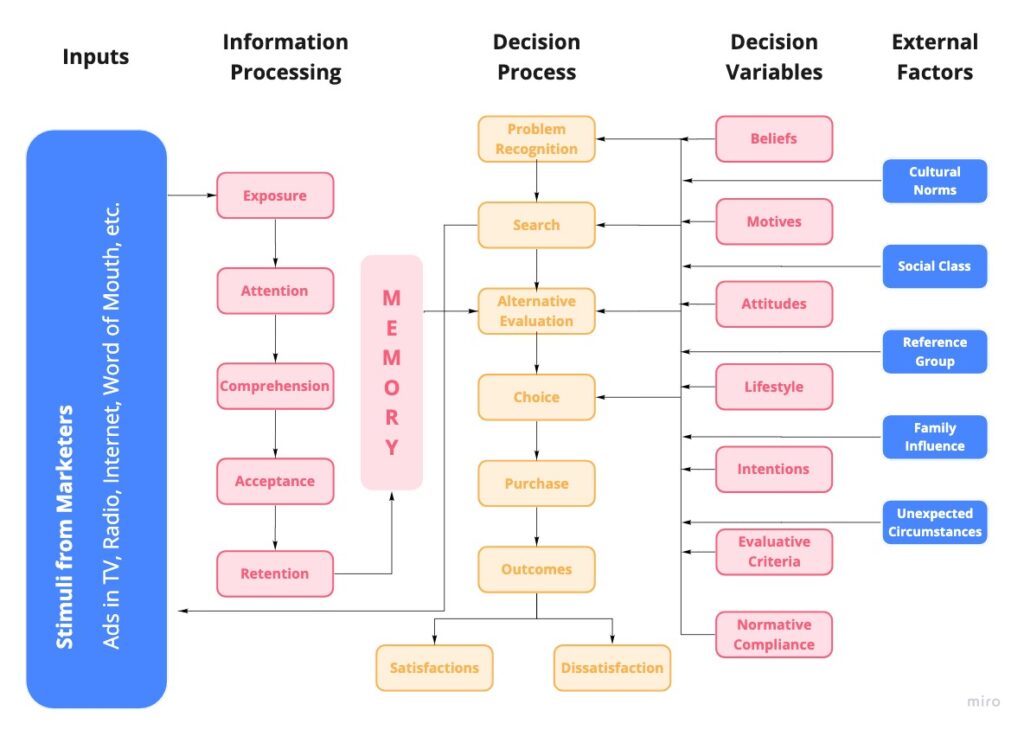What is Engel Kollat Blackwell Model?
The Engel Kollat Blackwell Model is a consumer behavior model of the cognitive process that helps to predict what customers are going to buy. The model consists of three different categories, namely: Present Situation – this is where the customer is at the current moment, Desired State – this is where the customer wants to be in the future and it will help them achieve their goals, and Pathway for Movement from one state to another – this includes various steps that may include various products or services which can help move towards their desired state.
When was the Engel Kollat Blackwell (EKB) model created?
EKB model was created in 1968. Later this model went through several revisions, updates, and improvements to become the Engel, Blackwell, and Miniard Model (EBM) in the 1990s.
Five stages of this model
The model consists of five stages namely: Information input, Information processing, Decision process stage, Decision process variables, and External influences.

Information Input
The input includes all kinds of stimuli that a person is exposed to. They trigger specific behavior patterns in people. The consumer is exposed to a number of things in the outside world, both marketing, and non-marketing items, to make decisions about his or her life. It may include the price or value of a product, the brand, and identity of a company, etc.
Information Processing
Information processing is made up of several different cognitive styles which are formed through experiences (learning) in life. The model uses situations to help determine the pros, cons, and potentials that are associated with this particular decision. The six cognitive styles in the model are:
Conscientious
People, who use information-based methods to help make decisions typically ask themselves questions about an issue or situation before proceeding. Example: I need to know more about ” Misconduct”, is this allowed? can work out a solution, etc.
Consultative
People who use the information to help make decisions are vaguely aware but have trouble making short-term decisions because of uncertainty or lack of experience when it comes to their situation they search for information that they believe will be useful to them in the long term. They need clarification about their decisions. Some examples are “I am now thinking of changing career paths. I don’t know what direction to take” or “This is an opportunity with financial benefits for me but I’m really unsure what to do”.
Imaginative
People who use information about solving problems and coming up with ideas in order to make decisions may actually start formulating a plan before finishing the question, Or begin spouting off solutions without even realizing it when they forget what that person is talking about or what they have been saying, speculating about potential problems.
Verbal
People who use manipulation as a way to help make decisions tend to talk themselves into thinking that this idea is good, even if it’s completely non-functional and makes no sense from a practical perspective, or they may begin with doubt and want to know if they are on the right track. “I have this feeling that it’s probably a bad idea” then they may use the pseudo justification of why It could be good before proceeding.
Visual-constructive
People who make decisions based on what they see, are very goal orientated and generate possibilities based on specifics of what is seen so it becomes more tangible for them. They need specific visual references to help them find an idea or project worth pursuing.
Logical
People who use logic as a way to make decisions would lack a vision or a direction but a heavy emphasis is put on formulating reasons why this idea could be better regardless of the negative consequences. They might say something along these lines: “I think it’ll work because I know that if we tried another way and failed, things wouldn’t go as planned” or “I think it’ll work because of this reason and that one, even though I don’t really like the idea”. Logical people would gather facts to justify their thinking.
Decision process stage
The stage focuses on the five basic decision process stages: Problem recognition, Search, Alternative evaluation, Choice, and Outcomes (Post-purchase evaluation and Behavior).
Problem Recognition
The problem recognition must happen before we can proceed with problem-solving. The brain is very good at recognizing problems but poor at finding solutions, so what will activate the problem recognition process? What could trigger your attention and make you recognize a potential problem that gets fixed during purchase selection? You may be interested in seeing how much problem recognition you’ve done prior to making your selection.
Information Search
The first thing people generally do after having recognized an issue or concern is search for solutions/options. There are many possible scenarios that may pop up in search mode; this happens to be the representative stage where possibilities bubble up based on what you’ve seen, heard, and thought. The amount of time spent searching for potential solutions depends entirely on how important/significant the issue is perceived by you (problem recognition); this is where you will most likely search for alternative solutions.
Alternatives Evaluation
It is an inter-relational stage of decision-making. This can be done by evaluating the choices through related thoughts and beliefs. Throughout the evaluation phase, several new possibilities may develop which are not necessarily thought to have already been discovered. This stage is the only opportunity for additional information gathering (research) and evaluating different alternatives.
Choice
By now there should be at least 4-5 solutions to choose from; rating, rating, and rating again will make this decision easier. The final choice normally consists of what goes against one’s values or what one feels is an obvious solution. It can be performed by either asking for help from a planned advisor/conversant, reading it over once again and writing down the choice, or choosing amongst many of them which are known as “blind taste test”.
Post Purchase Decisions
After consuming the product or service, you will be left with that experience. You may or may not continue using it or move on to the next purchase. Regardless of which, this is most likely where you will consider whether your purchase was worth your money and/or worth continuing with in the future.
Decision process variables
The model proposes that people’s opinions and choices make a difference to every stage of the decision-making process they are at. Culture, Emotional state, and environmental influences have been proven to heavily affect decision-making. There are different factors that can be altered by thought alone which helps in creating value for an individual consumer; these include attitude, learning styles (introversion vs extroversion), curvilinear models of decision making as well as dual-process models.
External influences
The external environmental influences include “Circles of Social Influence,” like culture, sub-culture, social class, and family. Social Challenges enforce influence on the consumer’s decision-making process. For instance, people feel uncomfortable purchasing alcoholic beverages from a guy other than their family. Family ties give context to product decision-making and help individuals select the products that they should buy because “family” or common interests are usually supported by those who have been buying stuff from them for years.
Limitations
As you can see, the EKB model is in many ways similar to the Howard Sheth model of consumer behavior. Therefore its limitations extend to this model as well. We suggest you check out our blog on the Howard Sheth model to compare and contrast each other.
